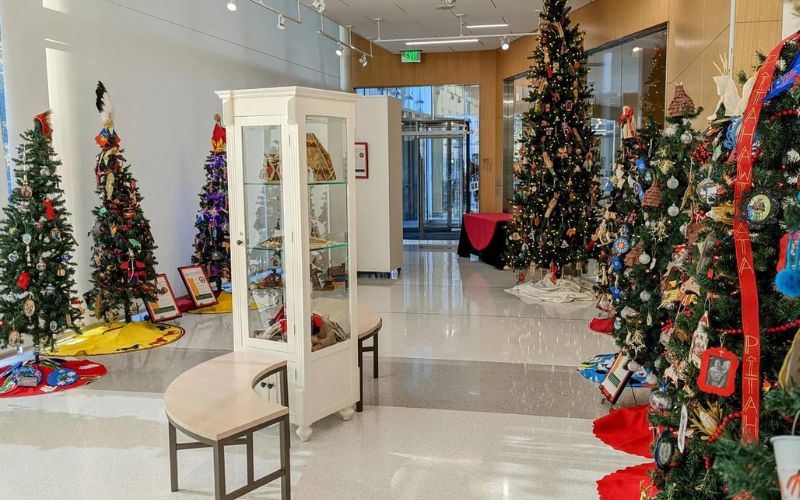
- Details
- By Kaili Berg
For many of us, an essential part of decking the halls for the holidays is getting our Christmas tree to look as festive as can be. Not only is it a fun family activity that helps get everyone into the holiday spirit, but it can also be an opportunity to showcase the lifeways, language, and heritage of Native Americans.
In downtown Oklahoma City, the ninth annual Red Earth TreeFest at the Red Earth Art Center is doing just that by showcasing the distinctive cultures of nearly a dozen of the 39 Tribal Nations headquartered in the state of Oklahoma through decorated holiday trees.
“With the intermingling that has happened with the removal, a lot of times in Oklahoma, Tribes can be tossed into one barrel,” Danny Sands (Seminole Nation), Red Earth Art Center Manager, told Native News Online. “This can really help to show highlights from different Tribes that make them unique,”
This year’s TreeFest includes trees decorated by the Caddo Nation, Cherokee Nation, Cheyenne and Arapaho Tribe, Citizen Potawatomi, Comanche Nation, Kiowa Tribe, Muscogee Creek Nation, Osage Nation, Ponca Nation, and Wichita and Affiliated Tribes.
 Make A Donation Here
Make A Donation Here
From clear glass bulbs filled with cedar, tobacco, and sweetgrass of the Citizen Potawatomi’s tree to a miniature teepee topping the Ponca Tribe’s tree, each tree celebrates the unique and diverse tribal palette of Oklahoma.
“Some Tribes so far have even put on painted ponies as well as some words that represent things similar to Christmas, as they did not have a word for Christmas back in those days,” Sands said.
A total of 38 tribal nations call Oklahoma home, creating a rich blend of culture for the state. While many of those tribes were forcefully removed from their ancestral homelands and moved to Oklahoma in the 19th century, the state’s Native American history extends all the way back to 30,000 years ago.
Students from the Norman Public Schools Indian Education program were also given the opportunity to decorate an intertribal tree with ornaments they made.
“In 2024, Red Earth will be running a photography program here where those students at Norman Public School can be prepared to learn to take pictures of dancers at powwows and things like that,” Sands said.
Red Earth Art Center is a non-profit organization featuring original Native artwork, both contemporary and traditional, from throughout the United States.
“Anything that we can do to promote Indigenous Arts and Culture is what we are trying to do,” Sands said. “Anything that can celebrate collaboration within the Tribes and anything that can allow people outside those Tribes to have more education on those Tribes is something that we are interested in not only for the holiday season but year-round.”
In addition to the trees on display, the Red Earth Art Center’s retail gallery space has additional trees decorated with handcrafted ornaments made by Oklahoma Native American artists that are for sale.
Red Earth TreeFest is free and open to the public from 10 a.m. to 5 p.m. weekdays through Dec. 29 in the Red Earth Art Center located in the lobby of the BancFirst Tower in downtown Oklahoma City.
More Stories Like This
Zuni Youth Enrichment Project Takes Top Emerging Artist Apprentices to Phoenix for Artistic Exploration and Cultural ImmersionFrom Dishwasher to Award-Winning Chef: Laguna Pueblo's Josh Aragon Serves Up Albuquerque's Best Green Chile Stew
Rob Reiner's Final Work as Producer Appears to Address MMIP Crisis
Vision Maker Media Honors MacDonald Siblings With 2025 Frank Blythe Award
First Tribally Owned Gallery in Tulsa Debuts ‘Mvskokvlke: Road of Strength’
Help us defend tribal sovereignty.
At Native News Online, our mission is rooted in telling the stories that strengthen sovereignty and uplift Indigenous voices — not just at year’s end, but every single day.
Because of your generosity last year, we were able to keep our reporters on the ground in tribal communities, at national gatherings and in the halls of Congress — covering the issues that matter most to Indian Country: sovereignty, culture, education, health and economic opportunity.
That support sustained us through a tough year in 2025. Now, as we look to the year ahead, we need your help right now to ensure warrior journalism remains strong — reporting that defends tribal sovereignty, amplifies Native truth, and holds power accountable.
 The stakes couldn't be higher. Your support keeps Native voices heard, Native stories told and Native sovereignty defended.
The stakes couldn't be higher. Your support keeps Native voices heard, Native stories told and Native sovereignty defended.
Stand with Warrior Journalism today.
Levi Rickert (Potawatomi), Editor & Publisher

